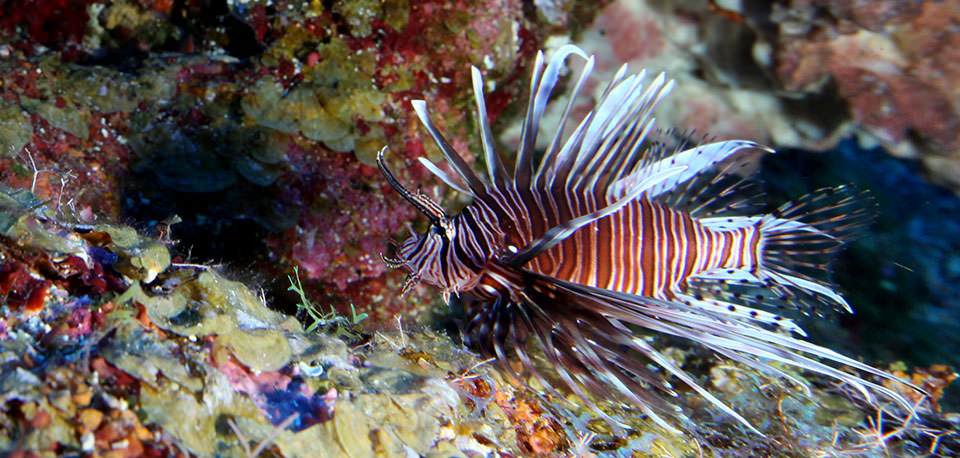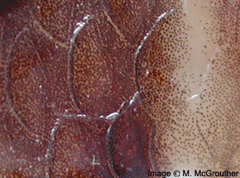What is a lionfish?
The lionfish is a carnivorous fish native to the Indo-Pacific that is now an invasive species in the Atlantic.

The lionfish, a longstanding showstopper in home aquariums, is a flourishing invasive species in U.S. Southeast and Caribbean coastal waters. This invasive species has the potential to harm reef ecosystems because it is a top predator that competes for food and space with overfished native stocks such as snapper and grouper. Scientists fear that lionfish will also kill off helpful species such as algae-eating parrotfish, allowing seaweed to overtake the reefs. In the U.S., the lionfish population is continuing to grow and increase its range. This is largely because lionfish have no known predators and reproduce all year long; a mature female releases roughly two million eggs a year.
Scientific Name: Pterois volitans (red lionfish) and Pterois miles (devil firefish)
Identification: Lionfish have distinctive brown or maroon, and white stripes or bands covering the head and body. They have fleshy tentacles above their eyes and below the mouth; fan-like pectoral fins; long, separated dorsal spines; 13 dorsal spines; 10-11 dorsal soft rays; 3 anal spines; and 6-7 anal soft rays. An adult lionfish can grow as large as 18 inches, while juveniles may be as small as 1 inch or less. Lionfish have cycloid scales (fish scales that are oval or elliptical in shape with a smooth edge).
A large group of invasive lionfish near St. Thomas, U.S. Virgin Islands, filmed during a Caribbean coral reef mapping expedition in April, 2015. During the 2015 Caribbean mapping expedition, 135 lionfish were spotted during a total of 26 dives. Lionfish were spotted as deep as 768 feet. Learn more about this mission.
Native Range: The South Pacific and Indian Oceans (i.e., the Indo-Pacific region). The range of the lionfish covers a very large area from western Australia and Malaysia east to French Polynesia and the United Kingdom's Pitcairn Islands, north to southern Japan and southern Korea and south to Lord Howe Island off the east coast of Australia and the Kermadec Islands of New Zealand. In between, the species is found throughout Micronesia.

The cycloid scales of lionfish. In this type of scale, the anterior part of each scale is usually overlapped by the posterior portion of the scale in front of it, giving the fish greater flexibility than fishes with other types of scales. There are four main kinds of scales (placoid, cosmoid, cycloid and ctenoid, and ganoid,) and numerous variations of each kind.
Non-native Range: Lionfish have been reported along the southeastern United States coast from Florida to North Carolina. Juvenile lionfish have been collected in waters off Long Island, New York, and Bermuda. Lionfish are a popular marine ornamental fish and were possibly intentionally released into the Atlantic. The first lionfish was reported in South Florida waters in 1985 with many additional sightings occurring until they were documented as established in the early 2000s.
Habitat: Lionfish are found in mostly all marine habitat types found in warm marine waters of the tropics. Lionfish have been found in water depths from 1 to 300 feet on hard bottom, mangrove, seagrass, coral, and artificial reefs (like shipwrecks).
Ecological Role: Lionfish are slow-moving and conspicuous, so they must rely on their unusual coloration and fins to discourage would-be predators from eating them. Lionfish are now one of the top predators in many coral reef environments of the Atlantic. Lionfish consume over 50 species of fish including some economically and ecologically important species. Lionfish are active hunters who ambush their prey by using their outstretched, fan-like pectoral fins to slowly pursue and "corner" them.
Behavior: Lionfish are thought to be nocturnal hunters, but they have been found with full stomachs during the day in the Atlantic. They move about by slowly undulating the soft rays of the dorsal and anal fins. During the day, they sometimes retreat to ledges and crevices among the rocks and corals. Although in the Atlantic, lionfish are often seen moving about during the day, both alone and in small groups.

Lionfish are native to the warm, tropical waters of the South Pacific and Indian Oceans (i.e., the Indo-Pacific region), including the Red Sea. Their native range is shown in orange on the map.
Economic Importance: Although lionfish have been used as a food source in their native range, economically, they are far more important in the aquarium trade. Lionfish are very popular and common aquarium fish, especially in the U.S.
Conservation Status: Lionfish are not currently listed as threatened or endangered in their native range. However, the increase in pollution in coral reefs may negatively affect the lionfish's primary food sources (crustaceans and fish). If lionfish are unable to adapt to declines in their prey species, their numbers may decrease.
Special Precautions: The spines of this species deliver a venomous sting that can last for days and cause extreme pain, sweating, respiratory distress, and even paralysis. Lionfish venom glands are located within two grooves of the spine. The venom is a combination of protein, a neuromuscular toxin and a neurotransmitter called acetylcholine (pronunciation: ah-see-toe-coe'-lean). After the spine punctures the skin, the venom enters the wound when exposed to the venom glands within the grooves of the spine. If you are stung by a lionfish, seek medical attention immediately.
Search Our Facts
Get Social
More Information
Biological Classification
- Kingdom – Animalia (all the animals)
- Phylum – Chordata (animals with a spinal cord)
- Subphylum – Vertebrata (animals with backbones)
- Class – Actinopterygii (ray-finned fishes)
- Order – Scorpaeniformes (scorpion fishes and sculpins)
- Family – Scorpaenidae (firefishes, goblinfishes, rockfishes, and scorpionfishes)
- Genus – Pterois (lionfishes, turkeyfishes, and zebrafishes)
- Species – volitans (meaning volatile or poisonous)

Last updated: 06/16/24
Author: NOAA
How to cite this article